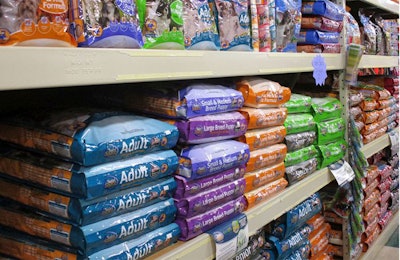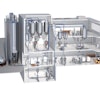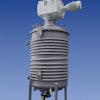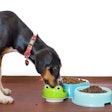
The mathematical "reconstitution" of dry ingredients with added water to affect the orders of predominance and ingredient percentage claims on pet food labels is a long-practiced, yet often incorrectly implemented, concept. A lack of understanding of proper application stems from the fact that minimal regulatory direction exists. The Association of American Feed Control Officials (AAFCO) fails to provide any guidance. In fact, the only document that alludes to the practice at all is a U.S. Food and Drug Administration (FDA) regulation, as follows:
21 CFR 501.4(c) When water is added to reconstitute, completely or partially, an ingredient permitted by paragraph (b) of this section to be declared by a class name, the position of the ingredient class name in the ingredient statement shall be determined by the weight of the unreconstituted ingredient plus the weight of the quantity of water added to reconstitute that ingredient, up to the amount of water needed to reconstitute the ingredient to single strength. Any water added in excess of the amount of water needed to reconstitute the ingredient to single strength shall be declared as water in the ingredient statement.
Importantly, the referenced "paragraph (b) of this section" includes several dry dairy and egg ingredients, but no mention of other commonly used dry ingredients. Application of this rule to ingredients outside the spectrum of those specifically mentioned (e.g., fruits and vegetables) may constitute a tangible risk.
Order of predominance on pet food labels
Granted, the mathematical reconstitution of dried broth as a means to replace "water" in the ingredient declaration is common in canned pet foods, and notwithstanding the fact that "broth" is not expressly included in the FDA regulation either, in practice it appears to provoke little regulatory consternation. Still, a strict interpretation of the regulation must be kept in mind when assessing potential risk.
Also, upon careful reading, the FDA regulation is only applicable to foods in which water that has been added remains in the final product; e.g., canned foods. Yes, water is typically added to ingredients to facilitate the processing of extruded pet foods, too. However, all that water (and then some) is subsequently removed during processing. As a result, that added water qualifies as an incidental additive and is not required to be declared on the final product label.
Assuming the water itself would never be declared, an assertion that reconstitution of dry ingredients can be accomplished with that same water is illogical. Also, even if that premise was valid, one cannot legitimately reconstitute dry ingredients in a preferential manner. If the water added to a mixture purportedly reconstituted the dried chicken ingredient, for example, it would also hypothetically reconstitute all the other dried ingredients, such as the grains. The net effect should be no material shift in those ingredients' order of predominance.
Substantiation of percentage claims
Beyond the issue of order of predominance as considered under the FDA regulation, manufacturers also use reconstitution as a basis for substantiation of percentage claims under AAFCO. Again, that may be a valid concept for canned foods, but it doesn't really work for products where that added water is ultimately removed.
As contemplated under the AAFCO regulation, a fruit (whether dried or not) can be added at 3% of the dry food formulation to substantiate a "with fruit" claim on the label. Even if after removal of the moisture (both that added and inherent in the ingredients) the actual percentage contribution of fruit is less than 3%, that still conforms to the rules, because percentages are based on amounts as they go into the formulation, not out. The same premise allows a manufacturer to add a high-moisture ingredient, such as fresh lamb, to a dry food mixture and still declare it as if its inherent moisture was still present; i.e., above the grains and other ingredients that are already low moisture prior to processing.
However, it can't go both ways. Adding a dried fruit at 1% but claiming that it is really at 3% on the basis of temporarily added water is not a sound assertion. Further, attempting to circumvent this distinction by procedurally reconstituting a dried ingredient before it goes into the mixture for final processing appears disingenuous at best.
Due caution warranted
Admittedly, the matter of whether an ingredient has been reconstituted in accordance with the FDA regulation is rarely an issue upon routine scrutiny. That is because feed control officials do not typically require access to the actual quantitative formulations for purposes of product registration, but rather take the ingredient lists as they appear on the labels at face value. However, discrepancies in orders of predominance and percentage claims could potentially arise if the product was subject to more rigorous regulatory review. Thus, due caution by manufacturers in application of the principles of reconstitution appears prudent.


















